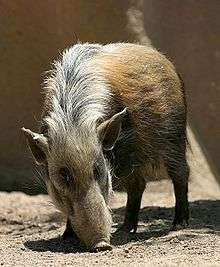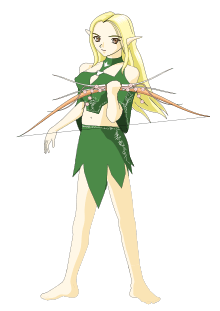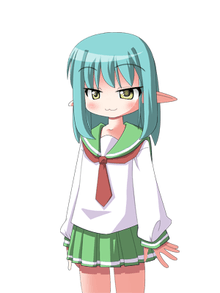Pointy ears
Pointy ears or pointed ears are a characteristic of numerous animals, at least one genetic disorder in humans, as well as a popular cliché in popular culture, particularly in the fantasy genre.
Animals

Pointy ears is a characteristic of some animals, for example the cat, the vampire bats,[1] civets and genets of the viverridae family,[2] red pandas[3] and African bush pigs.[4]
Humans
One of the characteristics of the Williams syndrome has been described as "pointed ears".[5][6] There are also cases of people being born with pointed ears not associated to William's syndrome. In one family a woman was born with two pointed ears, she later had a son with two less dramatically pointed ears, and she had a great uncle with one pointed ear. Some cases of pointed ears may be due to trauma to ears during labor, and the ear crease may unfold with time.
Folklore and fiction


Pointy ears have been a characteristic of some creatures in folklore such as French croquemitaine, Brazilian curupira[7] or Japanese earth spider.[8] It has been a feature of characters on art as old as that of Ancient Greece[9] and medieval Europe.[10]
Pointy ears are common characteristic of many creatures in the fantasy genre.[11] It's a common characteristics of races such as, among others, elves,[12][13][14] faeries,[15][16] pixies,[17] hobbits,[18] or orcs.[19] They are also a characteristic of creatures from the horror genre, such as vampires.[20][21]
This characteristic has been adopted into the Japanese anime and manga art style, where pointy ears are also a common trope of fantasy characters.[22][23] Manga and anime elves in particular are distinguished by very prominently displayed pointed ears, often drawn larger and more distinctly visible, as well as more angled, than in the Western works.[13][24]
Pointy ears have become associated with elves in Victorian literature of the 19th century.[14] Popularization of the pointed ears as an attribute of elves has been attributed to the works of J. R. R. Tolkien and their more recent big screen interpretation, though the status of elvish ears as canon is not universally accepted by the Tolkien fandom.[12][25][26][27]
Pointy ears are also found in the science fiction genre; for example among the Vulcan and Romulan races of the Star Trek universe[28] or the Nightcrawler character from the X-Men universe.[29]
See also
- Elves in fantasy fiction and games
- Fantasy tropes and conventions
- Donohue syndrome
External links
| Wikimedia Commons has media related to Pointy ears. |
References
- Pamela J. Gerholdt (1996). Vampire Bats. ABDO. p. 12. ISBN 978-1-56239-505-6.
- Joseph F. Merritt (4 February 2010). The Biology of Small Mammals. JHU Press. pp. 128–129. ISBN 978-0-8018-7950-0.
- Concise Encyclopedia Biology. Walter de Gruyter. 1 January 1996. p. 1015. ISBN 978-3-11-088956-7.
- Concise Encyclopedia Biology. Walter de Gruyter. 1 January 1996. p. 22. ISBN 978-3-11-088956-7.
- Mark H. Johnson; Yuko Munakata; Rick O. Gilmore (15 April 2008). Brain Development and Cognition: A Reader. John Wiley & Sons. p. 384. ISBN 978-0-470-75202-9.
- Scientific American (1 January 2008). What Makes a Genius?. The Rosen Publishing Group. p. 37. ISBN 978-1-4042-1401-9.
- Theresa Bane (4 September 2013). Encyclopedia of Fairies in World Folklore and Mythology. McFarland. p. 91. ISBN 978-0-7864-7111-9.
- Laurence Bush (5 October 2001). Asian Horror Encyclopedia: Asian Horror Culture in Literature, Manga, and Folklore. iUniverse. p. 43. ISBN 978-1-4697-1503-2.
- Johann Joachim Winckelmann (1850). The History of Ancient Art Among the Greeks. Chapman. p. 80.
- Alixe Bovey (2002). Monsters and Grotesques in Medieval Manuscripts. University of Toronto Press. p. 38. ISBN 978-0-8020-8512-2.
- J. Peffer (25 October 2012). DragonArt Collector's Edition: Your Ultimate Guide to Drawing Fantasy Art. IMPACT. p. 28. ISBN 1-4403-2417-4.
- Michael J. Tresca (16 November 2010). The Evolution of Fantasy Role-Playing Games. McFarland. p. 34. ISBN 978-0-7864-6009-0.
- David Okum (21 April 2006). Manga Fantasy Madness: Over 50 Basic Lessons for Drawing Warriors, Wizards, Monsters and more. IMPACT. p. 31. ISBN 1-60061-381-0.
- Sirona Knight (7 June 2005). The Complete Idiot's Guide to Elves and Fairies. DK Publishing. p. 171. ISBN 978-1-4406-9638-1.
- John Michael Greer (1 September 2011). Monsters. Llewellyn Worldwide. p. 107. ISBN 978-0-7387-1600-8.
- Christopher Hart (2008). Astonishing Fantasy Worlds: The Ultimate Guide to Drawing Adventure Fantasy Art. Watson-Guptill Publications. p. 103. ISBN 978-0-8230-1472-9.
- John Hamilton (1 August 2011). Elves and Fairies. ABDO. p. 23. ISBN 978-1-60453-215-9.
- Misha Kavka; Jenny Lawn; Mary Paul (2006). Gothic Nz: The Darker Side of Kiwi Culture. Otago University Press. p. 111. ISBN 978-1-877372-23-0.
- Lisa Hopkins (1 January 2010). Screening the Gothic. University of Texas Press. p. 202. ISBN 978-0-292-77959-4.
- Noah William Isenberg (13 August 2013). Weimar Cinema: An Essential Guide to Classic Films of the Era. Columbia University Press. pp. 96–. ISBN 978-0-231-50385-3.
- Ken Gelder (2000). The Horror Reader. Psychology Press. p. 27. ISBN 978-0-415-21356-1.
- Ikari Studio (28 March 2007). The Monster Book of More Manga. HarperCollins. p. 19. ISBN 978-0-06-115169-9.
- Anna Southgate; Keith Sparrow (August 2011). Drawing Manga Expressions and Poses. The Rosen Publishing Group. p. 17. ISBN 978-1-4488-4800-3.
- David Okum (15 March 2005). Manga Monster Madness. IMPACT. p. 34. ISBN 1-60061-387-X.
- "Do Tolkien's Elves Have Pointy Ears? | Middle-earth & J.R.R. Tolkien Blog by Michael Martinez". Middle-earth.xenite.org. 2011-09-21. Retrieved 2014-04-18.
- F.A.Q. "F.A.Q." The Tolkien Society. Retrieved 2014-04-18.
- Janice M. Bogstad; Philip E. Kaveny (9 August 2011). Picturing Tolkien: Essays on Peter Jackson's The Lord of the Rings Film Trilogy. McFarland. p. 86. ISBN 978-0-7864-8473-7.
- Henry Jenkins III; Tara McPherson; Jane Shattuc (2 January 2003). Hop on Pop: The Politics and Pleasures of Popular Culture. Duke University Press. p. 119. ISBN 0-8223-8350-0.
- William Irwin; Rebecca Housel; J. Jeremy Wisnewski (18 May 2009). X-Men and Philosophy: Astonishing Insight and Uncanny Argument in the Mutant X-Verse. John Wiley & Sons. p. 189. ISBN 978-0-470-73036-2.